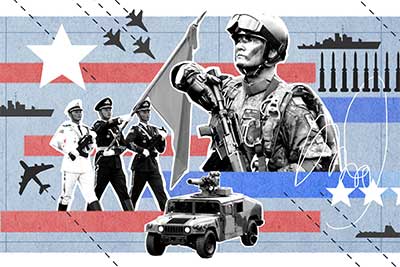Date : 01/06/2023
Relevance: GS Paper 2: International Relations
Keywords: United Nations Convention on the Law of the Sea (UNCLOS), South China Sea, Maritime security, Regional balance of power, Act East Policy
Context -
- China is expanding its military outreach to Southeast Asian countries, due to its intensifying geopolitical competition with the U.S. and its own security interests in the region,
What is Military Diplomacy?
- Military diplomacy is broadly understood as military-to-military interactions, activities and policies to build and maintain national security. This diplomacy includes a more advanced naval engagement, greater military exercises, and enhanced efforts for defence exports.
China's Military Endeavours in Southeast Asia:
- The PLA (People liberation Army) has been actively conducting joint military exercises and engagements with various Southeast Asian nations.
- Notable recent activities include the bilateral military exercise, Friendship Shield 2023, between the PLA and the Laotian People's Armed Forces (LPAF). This exercise aimed to enhance interoperability and counter transnational armed criminal groups based in forest and mountains.
- Additionally, China has conducted drills with Cambodia and the Singaporean Navy, focusing on joint anti-terrorism operations and maritime operations.
Factors Driving China's Growing Influence:
- China's military diplomacy in Southeast Asia is part of President Xi Jinping's broader reform process and foreign policy objectives.
- China seeks to strengthen its comprehensive national power and counter the expanding United States military engagement in the Asia-Pacific region, especially in areas where territorial disputes exist, such as the South and East China Seas.
- China's military activities aim to project power, establish influence, and assert its regional interests.
Challenges of the Global Security Initiative (GSI):
- China's GSI has elicited varied responses from ASEAN countries, reflecting divergent opinions on aligning with China or hedging against it with the United States.
- Some ASEAN countries have expressed confidence in the GSI, others are sceptical or hold reservations. The divergent responses highlight intra-association differences in bandwagon and hedging strategies. However, these responses alone do not determine how ASEAN countries perceive China's comprehensive national power.
Concerns Regarding recent U.S.-Philippines Proximity:
- China is particularly concerned about the increasing proximity between the United States and the Philippines. The Philippines shares a disputed maritime border with China in the Luzon Strait, a part of the South China Sea.
- China has viewed the Philippines' decision to grant the U.S. access to military bases as a cause for worry.
Implications for USA and India
- China's military diplomacy in Southeast Asia demonstrates its determination to establish influence and counterbalance the United States in the region.
- As the geopolitical competition between China and the United States continues, Southeast Asia remains a critical arena where both powers strive to shape the regional order.
- Geopolitical Challenges: It poses a challenge to India's Act East Policy and its strategic partnerships with countries in the Indo-Pacific region.
- Maritime Security: The South China Sea is a critical maritime route for India's trade and energy supplies. China's increasing military presence in the region and its potential to disrupt freedom of navigation raises concerns for India's maritime security.
- Regional Balance of Power: It can lead to a shift in the power dynamics and influence India's relationships with Southeast Asian countries.
- International Law and UNCLOS: China's actions in the South China Sea have raised concerns regarding adherence to international law, particularly the United Nations Convention on the Law of the Sea (UNCLOS)
Conclusion:
- China's military diplomacy in Southeast Asia has been driven by its geopolitical competition with the United States and its regional security interests. Through joint military exercises and engagements, China aims to assert its influence and counterbalance the growing U.S. presence in the region. However, varying responses from ASEAN countries, challenges posed by the Global Security Initiative, and concerns over the U.S.-Philippines proximity highlight the complexities of China's military diplomacy.
- China's military diplomacy in the South China Sea necessitates increased cooperation between India and other like-minded countries to counter aggression of China in the region.
Probable Questions for Mains Examination:
- Question1: Analyse the factors driving China's increasing military influence in Southeast Asia and its implications for regional security and stability. (10 Marks)
- Question2: Discuss the challenges posed by China's military diplomacy in Southeast Asia and the varying responses from ASEAN countries. How do these responses reflect intra-association differences in bandwagoning and hedging strategies? (15 Marks)
Source: The Hindu







